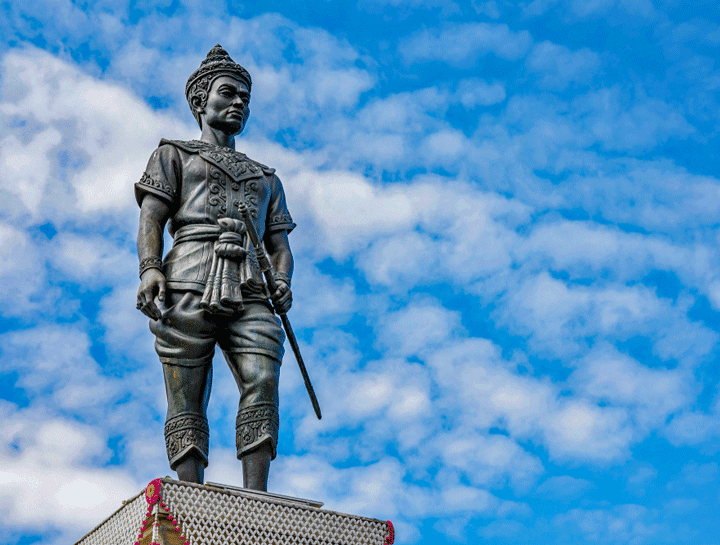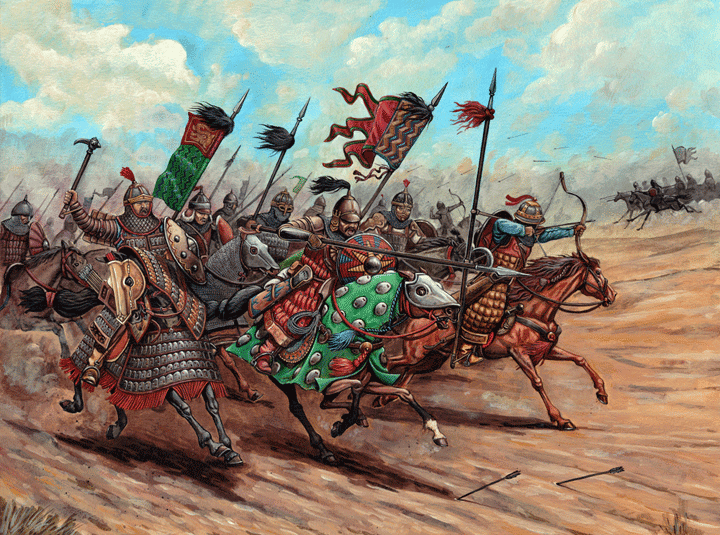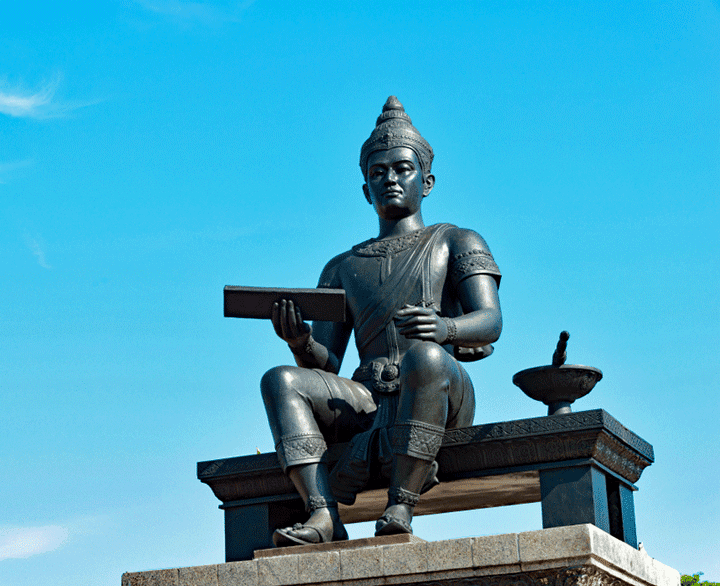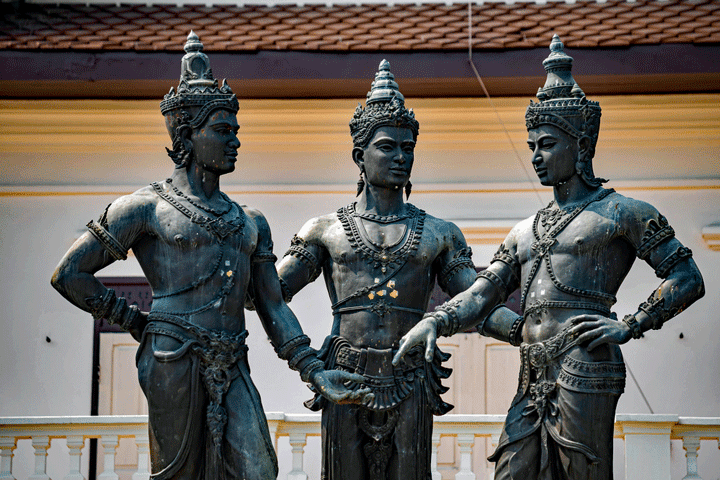“The Mad Fourteenth Century” – a Southeast Asian version

King Mengrai in Chiang Rai – (Jula Store / Shutterstock.com)
In 1978, the American journalist and historian Barbara Tuchman (1912-1989), published 'A Distant Mirror – The Calamitous 14th Century', in the Dutch translation 'De Waanzige Veertiende Eeuw', a sensational book about everyday life in medieval Western Europe in general and in France in particular, with wars, plague epidemics, and an ecclesiastical schism as the main ingredients.
Central to this book were the vanity of the nobility, kings and church princes who persisted in a stupid way of waging war and exploiting the peasants and citizens, who had to pay for all wars, parties and failures willy nilly...
'The Mad Fourteenth Century' would perhaps today be portrayed by the Woke adepts as a typical Eurocentric and therefore objectionable blank book and for once I have to follow their line of reasoning, for I can hardly claim that fourteenth-century France was filling up with colored fellow human beings, let alone that they were already colonized by the perfidious Paris.
All joking aside. There is something to be said for this approach, because within a global historical frame of reference, the fourteenth century in question could not only be classified as 'mad' in the West. Certainly in Asia in general and Southeast Asia in particular, this juncture did not go unnoticed. It is hardly known in the West, but the events that took place in the region in the fourteenth century have radically changed the region.
It all started with the Mongols. This feared equestrian nation launched a series of invasions into the Indian subcontinent between 1221 and 1327, more than once endangering the area we know today as Thailand. For example, in both 1238 and 1287, the kingdom of Pagan, which today roughly corresponds to Burma/Myanmar, was successfully attacked by the troops of the Mongol Yuan dynasty.

Attack of the Mongols
Kublai Khan drove the Burmese king south and formally incorporated the north of present-day Burma into his empire as Zhengmian Province. The border of this province extended into the present-day territory of Shan State and as far north as Thai and Mon principalities such as Haripunjaya (modern Lamphun), Pahyao, Chiang Saen and Chiang Rai. When Kublai Khan in the east marched against Champa and present-day Vietnam with a huge force, some sources say nearly half a million warriors, the northern Thai principalities seemed surrounded and consequently a bird to the cat. However, the brilliant Dai-Viet army commander Tran Hung Dao managed to deliver a crushing defeat to the Mongol war fleet on April 9, 1288 in the naval confrontation in the bay of the Bach Dang River, which removed the danger for a while.
It was therefore absolutely no coincidence that precisely in the year 1287 Mengrai, the prince of Chiang Rai, made a powerful alliance with Ramkhamhaeng of Sukhothai and Ngam Muang, the prince of Pahyao. Together, perhaps aided by the dense jungle, steep mountains and malaria mosquitoes, they managed to keep the Mongolian horde at a distance. Moreover, the shrewd Mengrai exploited the collapse of the Burmese empire to engage in territorial expansion.

King Ramkhamhaeng (beibaoke / Shutterstock.com)
In fact, the Mongol invasions were only one factor why the fourteenth century can also be described in this region as a 'mad century'. The third Mongol invasion, led by Timur Khan in 1300-1301, was successfully repelled by the Burmese Myisaing dynasty with the result that the Mongol hordes began to retreat towards China from April 1301. They left the northern Thai states virtually untouched. A fact that was mainly used by Mengrai not only to force Haripunjaya to its knees and to found Chiang Mai, but also to further expand his territory in all directions.
The first decades of the fourteenth century are therefore seen by many historians as the breeding ground for a number of important principalities in these regions. Mengrai's performance at least led to the creation of Lan Na'the kingdom of a Million Rice Fields' while east of Lan Na, on the upper reaches of the Mekong the Laotian principality of Lan Xan'the kingdom of a Million Elephants' arose. The same story also applies to Sukhothai, where the fall of Pagan, the temporary administrative chaos in China as a result of the struggles within the Mongolian hierarchy and the conflicts between Dai Viet and Champa led to the development of the still very young principality of Sukhothai, which broke with Khmer Empire.

The 3 Thai kings who founded Chiang Mai: Phaya Mangrai, Phaya Ngam Muang and King Ramkhamhaeng
The latter was possible due to the weakening of the once powerful Khmer Empire. Dynastic disputes over succession had weakened the once strong central authority, weakening control over the border areas of the empire. The threat of the South Vietnamese principality of Champa, which was once again growing stronger, but also long periods of drought and the excessively high population concentration had ensured that the once powerful empire had reached its limits. As if that were not enough, massive outbreaks of malaria – due to the increasingly poorly maintained dense network of waterways and storage basins – combined with the deadly bubonic plague caused many of the surviving Khmer to seek refuge elsewhere and the empire rapidly depopulated. This led, among other things, to a rather abrupt stop in the ambitious construction plans of the Khmer rulers.
The shifting of trading activities to sea trade eventually caused the same rulers to move to Phnom Penh, neglecting inland rice cultivation in favor of maritime trade. This choice also turned out not to be the best and would irrevocably contribute to the weakening of Khmer authority. It had gradually become clear to everyone in the region that the Lords of Angkor were on their teeth.
The Siamese of Sukhothai, who were largely spared from this disaster, realized that this was an excellent opportunity to build their own independent principality in the plain of Chao Phraya. A kingdom that was no longer indebted to anyone and that, according to the much revised official Siamese historiography of the early twentieth century, would form the cradle of modern Siam. Or how the 'Insane Fourteenth Century' had finally yielded something good for the Thai...


Great, I like history very much so I like to read contributions like this. Thank you!
Those who know the past know the present. Humanity has not changed one bit. The great self must be shown and honored on all levels and the killing of others is still as vivid as ever. The madness at its peak and the last we have not yet experienced.
Lung Jan
Never have I read such a clear and straightforward analysis of the political context in which kingdoms go and arise in South East Asia.
You clearly sketch how things go together and how everything resulted from the previous process in terms of process.
For example, I wondered for years where Mengrai suddenly came from, or how Sukhothai could arise.
You make the connections.
One of your best articles read so far!
A thought… Southeast Asia has also suffered from the Mongols.
When we now look at Mongolia (10 million inhabitants), it is hard to imagine that eight hundred years ago the core of the largest empire in the world of all time (after the British Commonwealth) was built there. The Mongols ruled from Europe to almost Japan. A hundred million people lived in that kingdom… Unbelievable!